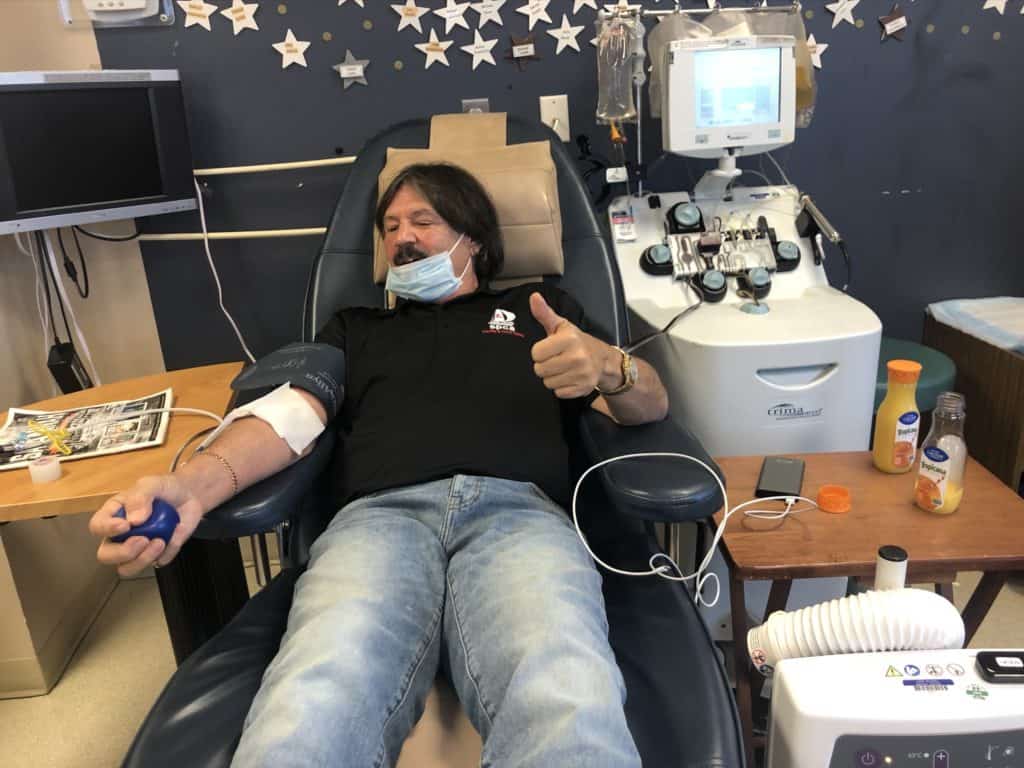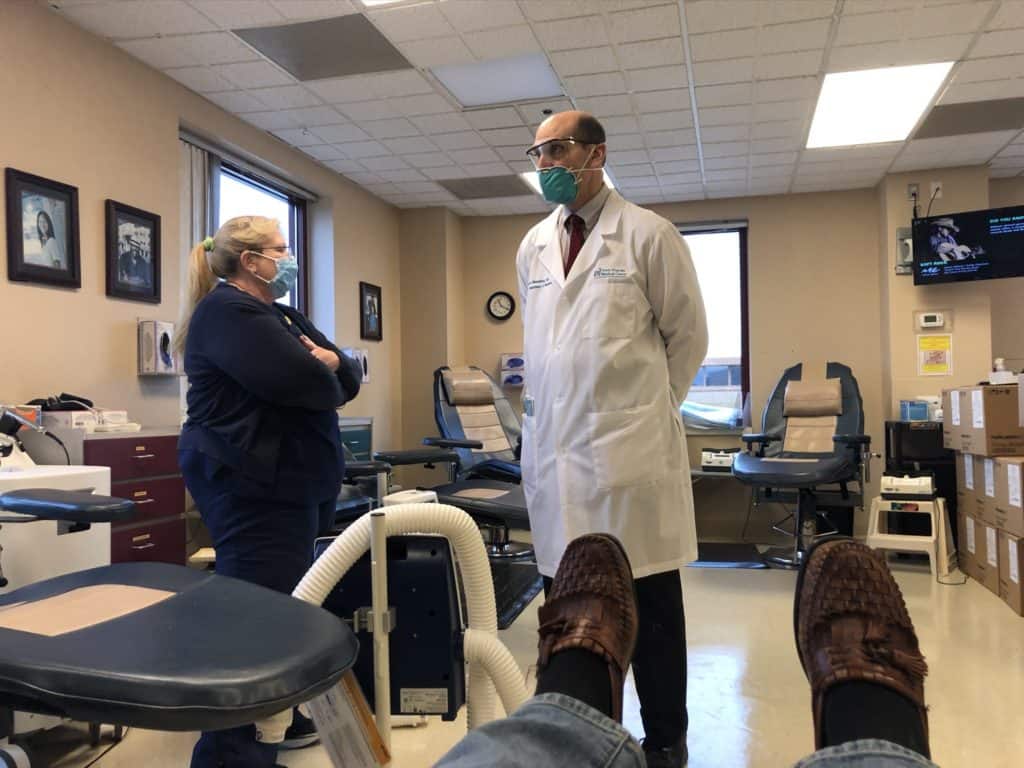A Gift of Life

Donors Help Others Fight COVID-19
By Krista Pfunder
Over the course of this pandemic, donations of money, food, clothing and supplies have poured in to help neighbors through these challenging times. Residents are embracing shopping locally and supporting restaurants with purchases of gift cards to help area businesses survive. In Annapolis, many have also been giving another kind of gift: life-saving, convalescent plasma.
Over 222,000 Marylanders have tested positive for COVID-19 and more than 4,800 have died of the virus. For those who have recovered, their bodies harbor important antibodies, part of the body’s immune defense against infection. Plasma is the portion of the blood which contains these antibodies.
“After an infection, the level of these antibodies is typically high beginning a month after the infection and lasting for several months,” says Dr. Barry Meisenberg, chair of medicine for Luminis Health Anne Arundel Medical Center. “This antibody-rich plasma can be collected from persons who have recovered from COVID-19 and administered for therapeutic purposes to other patients in three different situations.”
The three situations in which the plasma treatment is proving effective are in-hospital treatment, early treatment, and in the prevention of infection.
As convalescent plasma has not yet been approved by the FDA, it’s regulated as an investigational product. The FDA issued an Emergency Use Authorization in August. Luminis Health Anne Arundel Medical Center in Annapolis is the only facility in the area treating patients by giving them plasma transfusions.
In-hospital treatment is for patients who are acutely ill and have been hospitalized with COVID-19. “Many have benefited from receiving plasma — particularly if administered in the first few days of their illness,” Meisenberg says.
To provide convalescent plasma for early treatment, Luminis Health Anne Arundel Medical Center is participating in a nationwide study led by physicians at the Bloomberg Johns Hopkins School of Public Health. The goal is to see if convalescent plasma can prevent further deterioration or hospitalization in patients who are already infected but have mild-moderate symptoms.
“Patients are randomly assigned to receive either convalescent plasma or regular plasma without the antibodies,” Meisenberg says. “Patients are closely monitored, and an infusion must be within eight days of the first symptom so it is important to be evaluated early in the course.”
As a preventative treatment, people who may have had close contact with someone with COVID-19— such as a household member— can participate in a similar study of plasma to see if infection with COVID-19 can be prevented with an infusion of plasma. Infusion must be within five days of the last exposure so it is important to be evaluated soon after exposure.
Across the region, those who have recovered from COVID-19 are answering the hospital’s appeal for help by donating their plasma.
“Plasma is removed from a donor by starting an IV and spinning the blood in a machine that removes some of the antibodies and returns everything else to the patient,” Dr. Meisenberg says. “The process takes about an hour and other than the IV, is painless. The plasma is then frozen for subsequent use.”
A Personal Duty
One Anne Arundel County man has been donating his plasma for months and does it as often as he is able.
“I believe that I contracted the disease and recovered so that I could help others,” says Al Passori of Severna Park. “Plus, I have been donating whole blood, platelets and plasma to the AAMC Blood Bank for 50-plus years. It was a no-brainer for me.”
Passori says he contracted COVID-19 in Key West, Fla., in late February. “Mid-March I began experiencing the symptoms—lost my sense of taste, dry cough, headaches, serious gastrointestinal issues, fever of 103 for several days and I lost 27 pounds in 10 days before going to the emergency room,” Passori says. “A CT scan confirmed the disease attacked my lungs, as my breathing was labored and at 78% blood oxygen level while in the ER.”
After recovering, Passori heard about the plasma program from a friend, as it started up shortly after his recovery. “I’ve been giving COVID-19 plasma since mid-April and thereafter every 28 days,” Passori says. “I’ve been told that six to eight people benefit from a single plasma donation.”
The total time commitment to donate takes him between 60 and 90 minutes, Passori says.
“The staff are incredibly professional, competent and are very safety conscious,” Passori says. “Surprisingly, the needle is actually very small gauge. I barely feel it being inserted into the arm vein.”
Passori explains that he is asked to squeeze a ball every one to two minutes while he passes the time reading or checking his social media.
“At the end of the process, your plasma is collected, your red blood cells are returned, and the return line is flushed with saline,” Passori says.
The donating experience has been an overwhelmingly positive one for Passori.
“The staff will offer you juice, cookies and coffee — brewed onsite,” Passori says. “It’s a great venue for meeting caring and like-minded, good people who believe in giving the gift of life.”
Donating blood to save others has always been an important part of Passori’s life.
“Not everyone can — or should — donate lifeblood products,” Passori says. “I derive great satisfaction in knowing my actions can literally save a loved one’s or stranger’s life. There may be someone in your neighborhood or circle of friends who might need your plasma, blood or platelets.”
For Passori, helping others runs in the family. “I have been doing this for 50 years because my parents taught me that there is no greater sacrifice that doing good things for people in need,” Passori says. “My wife, LeeAnne Passori, saved over 38,000 babies in her lifetime as a baby blood donor before her unexpected death in 2019. I am so incredibly proud of her and continue to want to be more like her.”

Donors Wanted
More plasma is needed to continue to help patients recover from COVID-19. The hospital is hoping neighbors who have recovered from COVID-19 will contact them to donate. Since April 7, approximately 140 donors were able to provide plasma treatments to about 300 acutely ill hospitalized patients.
“Local donors are needed to supply this plasma at the Anne Arundel Medical Center Blood Bank,” Meisenberg says. “Persons willing to donate plasma — or who think they are eligible for the studies described above—should use the special email address set up for them: [email protected].”
